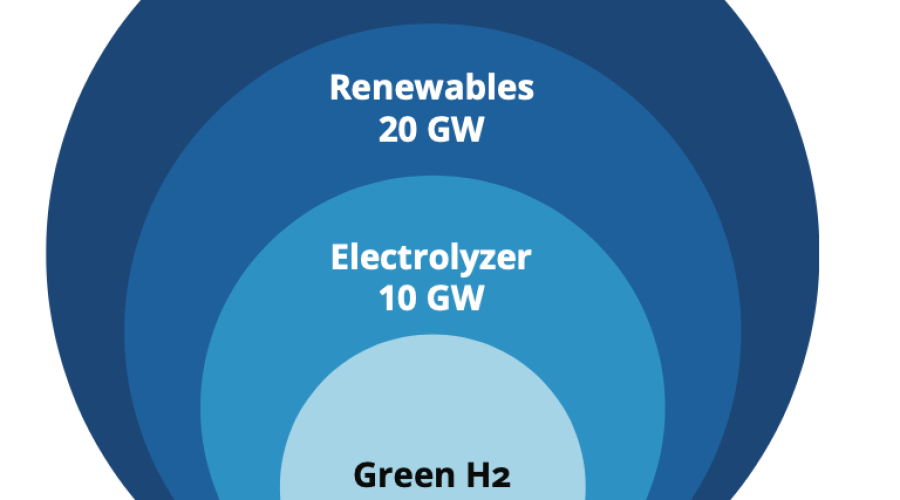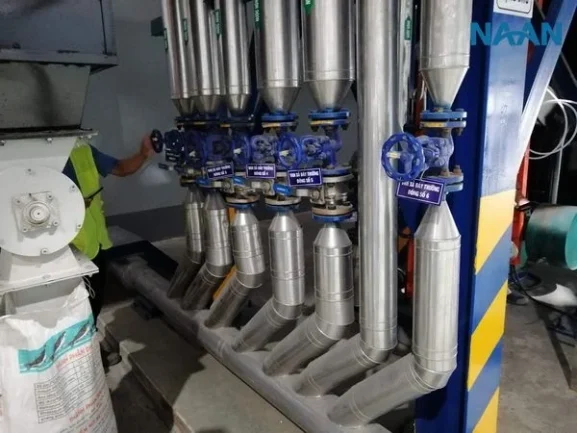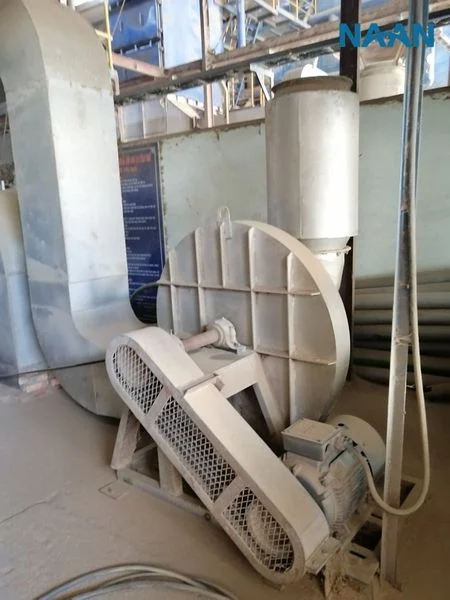SCALING HYDROGEN FINANCING FOR DEVELOPMENT
Clean hydrogen is widely seen as a key component of the global energy transition, notably for its potential to decarbonize hard-to-abate sectors, such as heavy industry (cement, steel, and chemicals), and heavy-duty transport (trucking, shipping, and aviation). A global hydrogen economy will change the geopolitics of energy and could become an engine for sustainable economic growth in emerging markets and developing countries (EMDCs). Several EMDCs are well positioned to become first movers in the development of this new value chain, both for domestic consumption and for export. Many countries have already issued strategies and roadmaps to operationalize their ambitions. As a next step, well-aligned policies adapted to those strategies are necessary to leverage private financing and mitigate the risks of first movers’ investments.
The cost of clean hydrogen is a major sticking point in its widespread adoption and deployment. While most attention to date has focused on innovation strategies to lower technology costs, financing costs have received less attention. This report analyzes the importance of the cost of financing, identifies the project risks that drive up such financing cost, and proposes risk-mitigation measures. The report describes how governments can support deployment by reducing the costs of both technology and financing.
Successful projects in the coming years will typically require a combination of strong sponsors, robust regulation, long-term offtake arrangements, and financial support. Governments have a key role to play in this early phase. Hydrogen policies on both the supply side and the demand side must be well integrated for the greatest effect and efficiency. A careful selection of early hydrogen projects can reduce the need for government financing.
Clean Hydrogen Production Must Grow Twenty-Fold by 2030
Realizing hydrogen’s potential means first replacing today’s fossil fuel-based hydrogen production with a cleaner variety. To meet the 2050 climate goals, today’s levels of clean hydrogen production must increase 20-fold (~40 Mt) through 2030. Today, less than
2 million tonne (Mt) of clean hydrogen is produced each year. Current projections suggest that of the 40 Mt of clean hydrogen production needed by 2030, an estimated two-thirds would come from renewables while the rest would be of the low carbon variety.
Clean hydrogen today is more expensive than conventional hydrogen produced from fossil fuels. This cost gap is the main factor why clean hydrogen projects are often viewed as unviable. Rule of thumb cost estimates for best-in-class projects with optimistic assumptions in favorable locations is $1/kilogram (kg) to produce conventional hydrogen, $2/kg for low carbon hydrogen, and $3/kg for renewable (green) hydrogen, respectively, though clean hydrogen (hydrogen from fossil fuels with carbon capture/storage) can already compete under certain favorable circumstances. Costs vary widely, however, especially for renewable hydrogen. Some EMDCs can be among the lowest-cost producers of clean hydrogen worldwide owing to their favorable renewables resource endowment. Moreover, their resource potential is very significant. This is a key reason why they should be part of early hydrogen development efforts. Existing country cost rankings from literature and modelling studies are of limited value as changing project specifics, market dynamics, and enabling environments can affect cost significantly. There is a need to develop more accurate hydrogen cost and pricing information for today and the coming years.
When hydrogen is traded internationally, the transportation cost can be as great as the production cost. That is a major reason why there is no international hydrogen commodity market. No significant shipping capacity for liquid hydrogen exists at present. Instead, hydrogen is being shipped in the form of ammonia, a globally traded commodity. Other synthetic hydrocarbon shipping options are being explored, and costs are projected to fall in the coming years. Pipeline transportation can be significantly cheaper than shipping for distances up to several thousand kilometers.
EMDCs Will Need $100 Billion in Investment Annually for Projected Growth in Clean Hydrogen
Existing hydrogen import policies, national plans, project pipelines, and model analyses indicate that 25 to 50 percent of clean hydrogen production is likely to come from EMDCs.3 The upper end of the range was used for this analysis (20 Mt of clean hydrogen production from EMDCs in 2030). These projections are uncertain; policy and regulatory frameworks will have a profound impact on choices of production locations and volumes for first movers.
FIGURE ES.1
Key Characteristics of Renewable Hydrogen Production by Component
Source: Authors’ analysis.

Scenario studies and the project pipeline suggest that EMDCs have the potential to attract clean hydrogen investments in the order of $100 billion per year between now and 2030, more than a ten-fold increase from present levels. Renewable hydrogen, which is more capital intensive than other forms, will account for 80 percent of the clean hydrogen production investment and financing needs.4
The external financial support needed to realize these investments in EMDCs and to close the economic viability gap is estimated between $10 and $40 billion per year between now and 2030. This amount is known as the “financing gap.”5 These amounts stand out in light of the fact that development financing worldwide presently totals just $200 billion per year. A number of strategies can be deployed to mobilize these investments, however, individual projects costing billions or tens of billions of dollars can pose particular challenges.
It will be essential to mobilize private sector financing for clean hydrogen to minimize dependence on scarce international and public financial support. Initiatives such as the World Bank’s recently launched Private Sector Investment Lab6, the blended finance principles
4 All investment and financing numbers in this publication include the renewable power component, which is not included in some other sources.
5 The “financing gap” refers to the difference between the level of financing needed and the level that is commercially justifiable. The gap is calculated based on the disparity between product value and production cost. The gap is equal to 10-40% of total financing needs.
6 The Private Sector Investment Lab aims to address obstacles to private sector investment in emerg- ing markets, with a focus on renewable energy and climate goals. It brings together private finance leaders and experts to develop solutions for mobilizing private capital to combat climate change and reduce poverty in these regions. The MDBs’ blended finance approach is described here.
embraced by multilateral development banks (MDBs), and the Blended Finance Principles of the Organisation for Economic Co-operation and Development7, as well as public-private partnerships to mobilize more private finance will be crucial to get initial projects off the ground.
The EMDC Project Pipeline is Full of Projects Stuck in Early Stages
Around 39 percent of today’s project pipeline is in EMDCs, with important activity concentrated in the Middle East, Latin America, India and China, followed by sub-Saharan Africa and other Asia. But translating high-quality renewable endowments into hydrogen production investments remains a challenge.
The main challenge for EMDCs is to push projects toward the front-end engineering design (FEED) stage. There is a relatively low representation of EMDCs (7 percent) at that stage, compared with developed countries (93 percent). To date, very few large projects have entered the final investment decision (FID) stage worldwide. The value of clean hydrogen projects in EMDCs that have reached the FID stage is less than $20 billion.
The share of investments in EMDCs is 44 percent, including China’s 18 percent share. However, the 44 percent figure is largely dependent on a few projects, such as NEOM in Saudi Arabia.
Because risk-mitigation measures are not far advanced, cost of capital is high and it is challenging to find offtake; many announced projects are stuck in early stages of development, struggling to complete the FEED studies.
Low-Cost Financing Must Be Combined with Lower Investment Costs
Projections of falling production costs for renewable hydrogen depend critically on two factors: lower installed costs of electrolyzer systems8 and competitive costs of renewable power. From the export perspective, transportation costs are also critical.
The production costs of clean and conventional hydrogen are expected to converge around 2030, provided greenhouse gas emissions are priced properly and the unit investment cost for renewable hydrogen maintains its downward trend. The convergence also depends on
whether the cost of capital declines as technology matures, as project developers gain experience, and as financiers become more comfortable with clean hydrogen projects. These factors can be mutually reinforcing.
To achieve 2030 convergence, a virtuous circle is needed in which governments support first movers’ projects by financing the technology, education, and scale needed to accelerate deployment and create a viable market.
The near-term prospects for reductions in electrolyzer cost remain uncertain. Today’s costs vary significantly by market, based on variations in costs in China, Europe, India, and the United States. The same uncertainty can be observed for the cost of electricity used to produce renewable hydrogen. The costs incurred by renewable electricity and the hours of electrolyzer operation will depend on the carbon standard that hydrogen production must meet. Initially, the interpretation of “low carbon” should be flexible enough to yield affordable hydrogen; the standard can be tightened in later years as the costs of renewable electricity and electrolyzers fall and as demand rises. But internationally traded hydrogen and hydrogen derivatives may have to comply with global standards and regulations, which can be complex and challenging. Clean hydrogen definitions and standards that have recently been set in Europe and ongoing discussions in the United States can provide relevant insights. EMDCs will have to balance standard setting and continue their dialogue with offtakers.
The relative cost differential between clean and conventional hydrogen is less pronounced for hydrogen derivatives, such as ammonia, steel, methanol, and jet fuel. Moreover, the ease of transporting these commodities creates an opening for the deployment of clean hydrogen in EMDCs, and the increase in value added makes a strong development case. Bringing manufacturing companies, shipping, and airline companies, for example, on board can accelerate hydrogen production in early stages and enable EMDCs to internalize a larger share of the hydrogen value chain.
The cost of capital affects both the levelized cost of electricity and the levelized cost of hydrogen production. Rich resource endowments in EMDCs compensate somewhat— but not entirely—for the higher cost of capital in EMDCs. Even high-quality projects with reputable partners and accompanied by sovereign risk guarantees typically require double-digit cost of capital in EMDCs.
Managing Risk Well Will Accelerate Clean Hydrogen Deployment
Certain essential factors must be present before a clean hydrogen project can make it to the FID stage. Secure offtake in terms of volume, price, and project duration must be in place. Infrastructure to handle hydrogen, water, electricity, carbon dioxide, and hydrogen derivatives must also be in place when production begins. In addition, the product must be recognized as ‘clean hydrogen’ by established standards and certification systems.

Post-FID risks center on construction overruns, offtake default, technology issues, political risk, and exchange risks, all of which affect the cost of capital and thus competitiveness. Once a project has reached the FID stage, targeted policies and risk-mitigation measures that reduce the cost of capital can decrease the cost disparity between conventional and clean hydrogen.
Some risks are country and actor dependent. These include the creditworthiness and credibility of the project sponsor; of the contractor responsible for engineering, contracting, and procurement; of the primary technology provider; and of the offtaker. All of these,
of course, feature prominently in any risk assessment. Some aspects of political risk can
be mitigated through well-established mechanisms offered by MDBs and development finance institutions (DFIs), such as political risk guarantees.
Clean hydrogen also carries perceived technology risks. Such risks can be mitigated by insurance or guarantees—for example, from export credit agencies in countries that produce electrolyzers. First-mover risk is also significant, where production costs are projected to fall in the coming years and product prices are likely to rise.
Governments Can Reduce Risk by Building Enabling Frameworks
Governments will play a vital role in the realization of clean hydrogen projects for the rest of this decade. They must create enabling policy frameworks and find solutions to close the financing gap for early projects.
Effective government policies can lessen the need for public financial support by creating the right enabling environment for investments, increasing pricing transparency, and reducing risk. Developed countries have already launched extensive mission-oriented strategies, with more than $100 billion in announced subsidies. EMDCs do not have the same financing power. However, careful selection of early hydrogen applications or an export-oriented strategy benefiting from partnerships with countries offering end-user incentives can substantially reduce financing needs.
Above all, governments must carefully choose the projects they wish to support in light of the projects’ quality and likelihood of success. Development of hydrogen hubs that cluster suppliers and producers can reduce the size of individual projects and eliminate the need for extensive transportation infrastructure. Whereas export projects are likely to be very large, smaller scale opportunities exist for hydrogen use nationally, such as in refineries or for fertilizer production. National uses can complement exports.
Given the complexity of the hydrogen sector, governments should consider the appointment or establishment of an agency responsible for national hydrogen development. Adequate policies, regulation, and financial instruments will be essential to lower risks and to attract patient capital such as pension funds and sovereign wealth funds. In this context, refinancing projects upon completion is a way to lower the cost of investment capital and to unlock sources of funding with a higher risk appetite.
International Financial Institutions Can Accelerate Hydrogen Financing
MDBs and DFIs should strengthen their support for EMDCs that are taking steps to advance the energy transition on their territory—for example, through support for carbon pricing schemes and rapid rollout of renewable power generation.
Equally deserving of support are knowledge sharing, capacity building, and promotion of international cooperation. Here, examples include certification schemes’ implementation, evolution of the market and pricing models, technical standards, and use of a single platform for channelling clean hydrogen development and climate funding and support. The World Bank’s Hydrogen for Development Partnership, established at COP27 and managed by WB/ ESMAP, is an example of such an effort.
For governments willing and able to become first movers, MDBs and DFIs can provide guarantees and deploy instruments to mitigate risks. This type of support includes technical
assistance, development policy financing, infrastructure loans (e.g., for ports and pipelines), facilitation of offtake arrangements (including demand aggregation), and strengthened matchmaking between EMDC governments and international hydrogen initiatives.
MDBs and DFIs are well positioned to support so-called lighthouse production projects designed to encourage further investment in EMDCs. This type of support includes (1) prioritizing and enhancing the quality of project proposals; (2) supporting the initial stages of project development; (3) pooling international development funding for investments to lower financing costs and raise investor confidence; (4) participating in blended finance arrangements; (5) offering risk-mitigation instruments; and (6) monitoring and quantifying the climate change and development benefits of clean hydrogen projects.
To date, international support has concentrated on making EMDCs attractive sites for hydrogen production by improving the enabling environment for incoming investment (most of it export oriented) and ensuring the adequacy of essential infrastructure. But such supply-side assistance could be strengthened on the demand side by devising the right mix of tax incentives, regulations, and policies to entice local companies to decarbonize their activities through the use of clean hydrogen. Stimulating local demand would widen the path to clean hydrogen investment by lessening the logistics and infrastructure costs associated with export-oriented investment.
Better coordination among participating international institutions can reduce transaction costs and speed up deployment—for example, through harmonization of approval and due diligence procedures. MDBs should consider developing a joint strategy to ensure that limited amounts of concessional and development financing are used to their maximum effect, notably for projects in the early stages of development.
Advancing Support for Renewable Hydrogen Financing
COP28 will provide an opportunity to discuss support for renewable hydrogen lighthouse projects facilitated by MDBs and DFIs acting in concert. Lighthouse projects are necessary to accelerate the scaling up of the clean hydrogen market. Active government and financing institution support will be needed to operationalize a pilot program, tentatively with a 10-gigawatt (GW) electrolyzer capacity reaching the operational stage. Such a program can increase investor confidence in various EMDC settings, leading to lower financing costs and easier access to capital. Given its urgency, the effort should screen projects from the existing pipeline, using criteria such as diversity, replicability, project size, and cost effectiveness.





